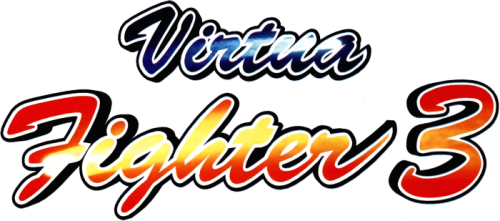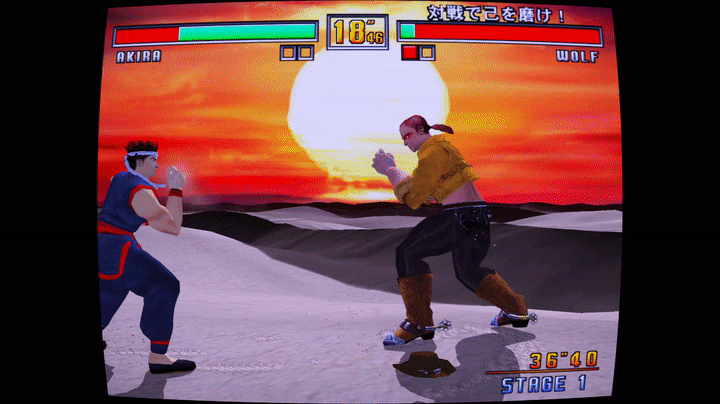Virtua
Fighter 3

REVIEW:
Continuing the tradition in VF1-VF2, the third
installment of Virtua Fighter adds 2 new characters. Aoi
Umenokouji (a Aiki Ju-Jutsu user) and
Taka-arashi
(an massive sumo wrestler) join the iconic roster of 3D martial artists. Virtua Fighter 3 took fighting games into uncharted territory with innovative "multi-tiered" stages. Fighting on stages with uneven ground —
including a slanted rooftop and the Great Wall of China —
was one of VF3's most notable and innovative gameplay elements, giving the game a "next gen" 3D feel in 1996. While the wide-open, multi-tiered stages were an element that naturally appealed to casual fans at the time, some hardcore VF players were put off by the unpredictability (and glitchy-ness) of the new stages —
strongly preferring the square rings VF
and VF2 when it comes to competitive gameplay.
|

|
|
Virtua
Fighter 3 character selection screen.
|
Virtua
Fighter 3 plays very familiar to prior installments, giving returning
players a comfortable place to pick up and play from the start. However, the new "Evade"
button brings the series into a truly 3D space for the first time ever, enabling characters to sidestep either left or right to dodge opponents' attacks and get better placement on stages to avoid Ring Outs. This new element would come to define future 3D fighting games for many years to come.
Ring Outs are still possible on most stages. In VF3, several stages are located on high ground —
as characters can get knocked off edges and fall long distances to the ground. It doesn't change the gameplay in any way, but it's a pretty cool and dramatic presentation element that future 3D fighting games like Dead or Alive 2 would elaborate on and flesh out further. VF3 stages also introduce obstacles, like an actual subway train on
Sarah's subway stage. And yes, characters can get hit by the train.  (And don't worry, VF characters are made of shiny polygons and don't actually bleed, so it doesn't really
hurt them.)
(And don't worry, VF characters are made of shiny polygons and don't actually bleed, so it doesn't really
hurt them.)
|

|
|
Groundbreaking
visuals for 1996 and 1997.
|
Returning characters in VF3 are given quite a few new moves and throws to keep things fresh, while looking crispier than ever thanks to the updated character models and new costumes.
With more polygons per character model, fighters appear more humanlike and
considerably less "pointy" than in past installments. Graphically, facial details and textures
are also among the best seen at the time. Overlooking some muddy textures and poorly-rendered background objects, VF3 was ahead of its time and easily
one of the best looking 3D fighters (and video games) in 1996.
|

|
|
Satisfying
animations and interesting gameplay moments.
|
Say what you will about Virtua Fighter 3, but Sega was experimenting with new tech that hadn't appeared in any fighting game before it. Sega was thinking outside the box and innovating (while many other fighting games were completely stuck in 2D)! Like past installments, Virtua
Fighter 3 proved to be a very successful and well-received arcade fighting game (especially in
Japan). An eventual Sega Saturn port was planned and even announced, but due
to the Saturn's hardware not being able to handle VF3, the home port was
moved to Sega's new system, the Dreamcast.
In 1998 (Japan) and 1999 (Worldwide), an updated version titled "Virtua Fighter 3TB"
(Team Battle) was released worldwide on the Sega Dreamcast. The game remained
largely the same as the arcade version, with the addition of Team Battle
mode being the main new attraction. In Team Battle, after selecting a team of 3 characters, players can take on a CPU team of 3 fighters (fighting one by one) or fight a local friend's team. Unlike
SoulCalibur, the Dreamcast
version of VF3 was actually inferior to the arcade version in terms of
graphics. There are some issues with the Dreamcast version (such as getting stuck in an in-game menu and not being able to return to the main menu), but otherwise... VF3TB is a fairly solid port.
 FUN FACTS:
The Dreamcast version of Virtua Fighter 3TB includes 4 different camera angles the player can choose from (by hitting the left trigger button) while fighting the CPU, including a 1st-person camera, 3rd-person view, and birds eye view. The
Dreamcast port also includes a History mode which shows of the series animation development over the years, including some never-before-seen behind the scenes footage. FUN FACTS:
The Dreamcast version of Virtua Fighter 3TB includes 4 different camera angles the player can choose from (by hitting the left trigger button) while fighting the CPU, including a 1st-person camera, 3rd-person view, and birds eye view. The
Dreamcast port also includes a History mode which shows of the series animation development over the years, including some never-before-seen behind the scenes footage.
|
|

| Page Updated: |
November
29th, 2023
|
| Developer(s): |
Sega-AM2
Genki Dreamcast |
| Publisher(s): |
Sega
|
| Designer(s): |
Yu Suzuki
|
| Platform(s): |
Arcade
Dreamcast (as
VF3tb)
|
| Release Date(s): |
Sept.
1996
Arcade
Sept. 1997 VF3: Team Battle
Update
Nov. 27th, 1998
 Dreamcast - as VF3TB Dreamcast - as VF3TB
Oct. 14th, 1999
 Dreamcast - as VF3TB Dreamcast - as VF3TB
Oct.
18th, 1999  Dreamcast - as VF3TB Dreamcast - as VF3TB
Nov. 28th, 2023  Arcade ALL.Net Update - as VF3TB
Arcade ALL.Net Update - as VF3TB
|
| Characters: |
Akira
Yuki, Taka-Arashi, Aoi
Umenokouji, Pai Chan, Lau
Chan, Sarah Bryant,
Jacky Bryant,
Kage, Jeffry
McWild,
Wolf Hawkfield,
Shun Di,
Lion Rafale, Dural
|
|
|
|
Featured Video:
|
|
|
| Related Games: |
Virtua
Fighter, Virtua Fighter Remix, Virtua
Fighter 2, Virtua Fighter Kids, Virtua
Fighter 4, Virtua Fighter 4 Evolution,
Virtua
Fighter 5, Virtua Fighter 5 R, Virtua
Fighter 5 Final Showdown,
VF5: Ultimate Showdown, Fighting
Vipers, Fighting Vipers 2, Fighters
Megamix, Last Bronx,
Ehrgeiz: God Bless The Ring,
Tekken 3,
Tekken Tag Tournament, Soul Calibur,
Dead or Alive,
Dead or Alive 2
|
|

|
|
Gameplay
Engine
|
8.5 / 10
|
|
Story
/ Theme
|
6.0 / 10
|
|
Overall
Graphics
|
10 / 10
|
|
Animation
|
9.5 / 10
|
|
Music
/ Sound Effects
|
6.0 / 10
|
|
Innovation
|
9.0 / 10
|
|
Art Direction
|
7.0 / 10
|
|
Customization
|
7.0 / 10
|
|
Options / Extras
|
7.0 / 10
|
|
Intro / Presentation
|
8.0 / 10
|
|
Replayability / Fun
|
8.0 / 10
|
|
"Ouch" Factor
|
9.5 / 10
|
|
Characters
|
8.0 / 10
|
|
BOTTOM LINE
|
8.2
/
10
|
|
Review based on Dreamcast version
|
|
| Final
Words: |
The epic jump from VF1 to VF2 was hard to match... At the very least, Virtua Fighter 3's introduction of the "Evade" technique brought the gameplay into a truly "3D" feeling space, with characters now able to move in three dimensions, not just back and forth like in earlier games. VF3's "Evade" is
comparable to the "sidestep" technique introduced in TEKKEN 3.
Although Sega
clearly "raised the bar" once
again in terms of graphics and overall presentation, VF3's gameplay
enhancements proved not to be as revolutionary as it set out to be... but the game was definitely ambitious for its time. I remember having some good times with this
installment... both in arcades and on the Dreamcast with VF3TB. However, I definitely didn't play VF3 nearly as long as other 3D fighting games of the era.
VF's character
designs still lack personality in VF3, which became more and more
apparent as time went on in the late 90's, with characters from other modern 3D fighting games were showing off eons more
charisma (and dialogue). The arcade version of VF3 definitely had some "wow factor"... but by the time of the Sega Dreamcast, VF3TB left something to be desired, and was outshined by other recent Namco fighting games, such as SoulCalibur. Nonetheless,
VF3 was a respectable stepping stone in the history of the series.
~TFG
Webmaster
| @Fighters_Gen
|
|
|
|
|
|
|
|
|
|
|
|
|